Effective SEO Keyword Research Strategies for 2025
- Published on

- What is Keyword Research?
- What is a Keyword Modifier and Its Role in SEO?
- The Essence of Keyword Research
- Why is Keyword Research Essential in SEO?
- Understanding User Needs and Search Behavior
- Optimizing Content Strategy Based on Data
- Building Long-Lasting Content Value
- Maximizing Efficiency and Avoiding Resource Waste
- How to Conduct SEO Keyword Research for a New Website
- Step 1: Identify Your Business Niche
- Step 2: Generate Keyword Ideas
- Difference with Phantom Keywords
- Effectiveness of Expanded List Post
- When to Use?
- Fluctuation in User Intent
- Limitations of SEO Tools
- How to Address These Issues
- Step 3: Define Criteria for Keyword Selection
- Step 4: Categorize Keywords by Search Intent
- Step 5: Group Keywords
- Step 6: Expanding Keyword Ideas
- Tips for Choosing Keywords for Implementation
- How to Find Keyword Ideas for an Existing Website
- #1. Analyze Your Existing Ranked Keywords
- #2. Refer to Competitors' Ranked Keyword Lists
- #3. Use Professional SEO Keyword Research Tools
- #4. Effective Niche Market Research
- Popular Keyword Research Tools
- How to Choose the Right Tool
- Differences Between SEO Keywords and Google Ads Keywords
- SEO Keywords
- Google Ads Keywords
- Overview Comparison: SEO Keywords vs. Google Ads Keywords
- When Should You Use SEO Keywords and Google Ads Keywords?
- Combining SEO Keywords and Google Ads Keywords: A Comprehensive Strategy
- Conclusion: Keyword Research – The Key to a Successful SEO Strategy
- Key Takeaways:
In an era where Google, Bing, or Cốc Cốc are indispensable tools for information searching, getting your website to the top of search results has become a top priority for businesses. However, to achieve that, keyword research is a crucial step that cannot be overlooked. It serves as the foundation for building an effective SEO strategy, attracting the right target customers, and optimizing marketing resources.
What is Keyword Research?
Keyword Research is the process of searching for, analyzing, and selecting the appropriate keywords that users often use to query information on search engines. However, it goes beyond just finding keywords; keyword research also includes analyzing search intent and evaluating the feasibility of keywords, enabling you to sustainably optimize your content.
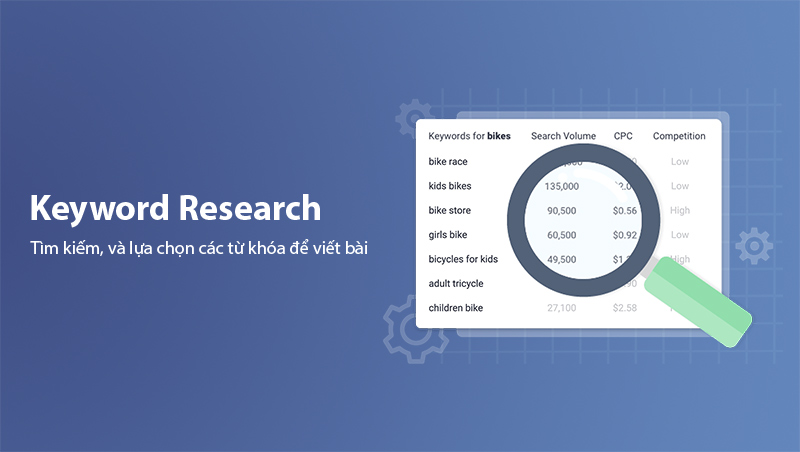
What is a Keyword Modifier and Its Role in SEO?
During keyword research, Keyword Modifiers act as tools to refine and expand the meaning of primary keywords, helping you target the right audience and increase conversion potential. These are words or phrases added to the primary keyword to clarify user intent.

Examples of Keyword Modifiers
- Primary Keyword: “men's sports shoes”.
- By adding modifiers, you can create keywords like:
- “authentic Nike men’s sports shoes”: Targets customers looking for products from a specific brand.
- “cheap men’s sports shoes in Ho Chi Minh City”: Targets buyers with budget-conscious needs or regional preferences.
Modifiers such as "cheap," "premium," "in Hanoi," "latest" not only add specificity to keywords but also help identify search intent, enabling you to optimize your content more effectively.
The Role of Keyword Modifiers in SEO
-
Classifying Search Intent:
Modifiers help you identify whether users are seeking information (Informational Intent), comparing options (Investigational Intent), or shopping (Transactional Intent).
Examples:- Informational: "Best men’s sports shoes of 2024."
- Transactional: "Buy authentic Nike sports shoes online."
-
Reducing Competition and Increasing Rankings:
Keywords with modifiers are often longer (Long-tail Keywords), less competitive, and easier to rank higher in search results. -
Boosting Conversion Rates:
By targeting the precise intent of the searcher, you can craft more compelling content, guiding customers to take action (like making a purchase or signing up for a service).
The Essence of Keyword Research
Keyword research is not merely listing popular keywords; it is a process of online market research. Its essence lies in understanding:
- Search Intent of users.
- Query Paths that potential customers follow.
- Data insights that guide your content strategy accurately.
Understanding Search Intent Behind Keywords
Each keyword carries a distinct search intent. To optimize content effectively, you need to clearly analyze what users aim to achieve when they input that keyword into a search engine.
Example:
- For the keyword "Europe travel", users might be looking for general information about destinations, culture, or travel experiences.
- For the keyword "cheap Europe travel packages", it indicates a search intent for affordable tours or specific promotional deals.
Classifying Search Intent with Keyword Modifiers
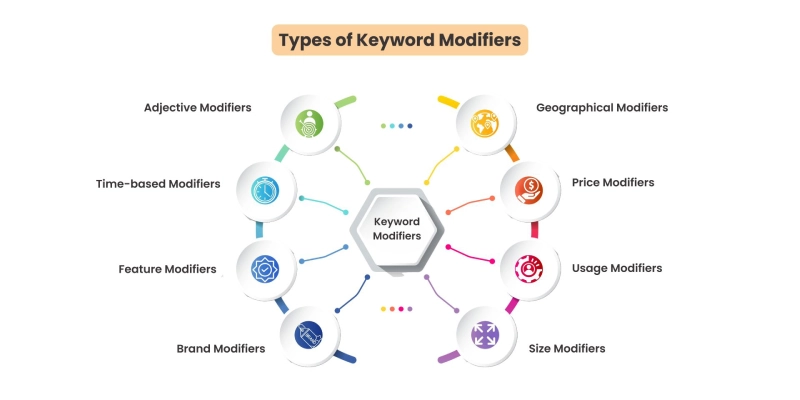
Search intent is divided into three main categories:
- Informational: Users seek to learn information. Example: “How to take care of British Shorthair cats.”
- Investigational: Users compare products or services. Example: “Compare British Shorthair and Persian cats.”
- Transactional: Users are ready to take action, such as making a purchase. Example: “Buy British Shorthair cats at a good price in Ho Chi Minh City.”
Keyword Modifiers clearly classify these intent groups, aiding in optimizing content to meet customer needs.
Understanding Users' Query Path
The Query Path is the sequence of queries users make during their search journey. Understanding this journey helps you anticipate their next steps and create content suitable for each stage.
Example:
- Stage 1: Searching for basic information → Keyword: “What is SEO”.
- Stage 2: Digging deeper → Keyword: “What does an SEO specialist do”.
- Stage 3: Taking action → Keyword: “Best online SEO courses”.
Data-Driven Strategy Foundation
Keyword research provides metrics like:
- Search Volume: Indicates user interest.
- Keyword Difficulty: Assesses keyword competitiveness.
- Relevance: Prioritizes the most suitable keywords for your product/service.

Why is Keyword Research Essential in SEO?
Keyword research is not just a step in the SEO process but the foundation for understanding customers, creating relevant content, and effectively optimizing your strategy. Here are four key reasons why keyword research is indispensable in any SEO campaign:
Understanding User Needs and Search Behavior
Through keyword research, you can answer critical questions:
- What are users really searching for?
- What issues are they concerned about in your field?
Example:
- Users searching for "classic wooden furniture" often look for premium products with sophisticated designs and high quality.
- On the other hand, those searching for "how to choose furniture for small homes" need guidance and practical solutions for compact spaces.
When you understand user behavior and needs, you can create content that addresses their issues directly, increasing engagement and trust.
Optimizing Content Strategy Based on Data
Keyword research provides vital data, such as:
- Search Volume: Shows which keywords attract the most interest.
- Keyword Difficulty: Helps prioritize keywords that are easier to rank for in the short term.
- Relevance to your product/service: Ensures your content aligns with actual user needs.
Using this data, you can:
- Develop detailed and goal-oriented content plans.
- Focus on keywords that bring the highest value to your SEO campaign.
Building Long-Lasting Content Value
Both trending keywords and evergreen keywords are ideal choices for content development.
Example:
- Trending Keywords: “Smart furniture for 2024” — Suitable for short-term exploitation.
- Evergreen Keywords: “How to preserve wooden furniture” — Provides lasting value regardless of timing.
These keywords enable you to not only optimize content for specific periods but also build a sustainable content repository, driving organic traffic over the long term.
Maximizing Efficiency and Avoiding Resource Waste
Keyword research helps identify strengths and opportunities, focusing resources on keywords that are:
- Moderately competitive.
- Relevant to your website’s current capabilities.
- High in conversion intent, such as transactional or investigational keywords.
Instead of spreading resources thinly over generic or highly competitive keywords, you optimize time, effort, and costs to achieve maximum results.
How to Conduct SEO Keyword Research for a New Website
This guide will teach you how to select effective keywords, categorize them, and evaluate their feasibility in SEO implementation. By doing so, you can optimize a keyword set with high search volume and conversion rates, deploy it systematically, and save time and effort while achieving excellent results.
Step 1: Identify Your Business Niche
Defining your business niche is the first and most crucial step in SEO keyword research. It helps you understand the industry, products/services you or your clients offer.

How to Identify Your Business Niche
- Understand your products/services: Identify unique features and the value they provide.
- Analyze competitors: Review their strategies, content, and keywords.
- Stay updated with market trends: Keep track of changes in your industry.
Define Your Target Audience
Analyze the demographic characteristics of your target audience, including:
- Age
- Gender
- Location
- Interests
- Needs
Example
A website providing information about pet cats without selling cats or related products might:
- Offer information about cat breeds.
- Share cat care knowledge.
- Recommend quality products or places to buy cats.
Revenue sources for this website could include:
- Google AdSense: Display ads.
- Affiliate Marketing: Promote products/services from related providers.
Step 2: Generate Keyword Ideas
Keyword ideas don’t require complex creativity. Instead, it’s a process of discovering keywords based on your field of activity.
Start with Seed Keywords
"Seed Keywords" are short keywords, usually one or two words, with high monthly search volume and high competition. These keywords identify your niche market and serve as a foundation for expanding to long-tail keywords.
Examples:
- "cat care"
- "cat food"
- "buy a cat"
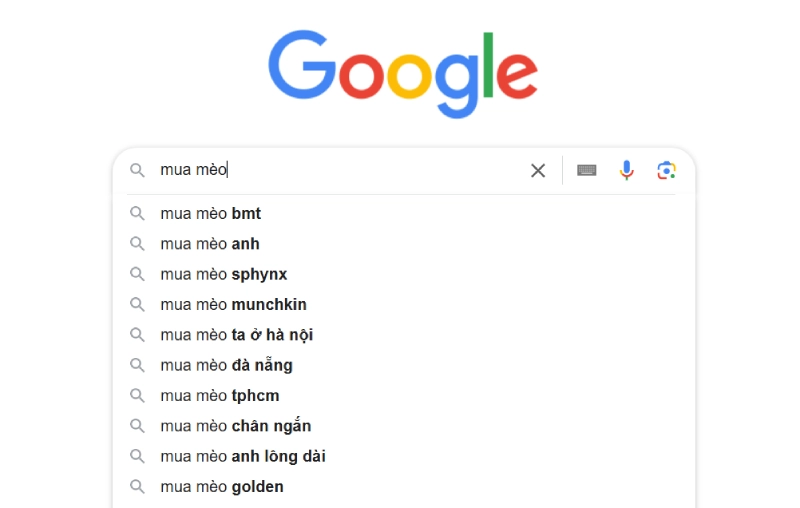
Once you identify seed keywords, you can use them to apply other keyword expansion methods, such as Universal Keywords.
Universal Keywords Method
The Universal Keywords Method builds comprehensive, targeted topics for your website based on your target market. This approach helps you select key topics to optimize SEO.
How to Apply
Simply input your seed keywords into a keyword research tool and hit Enter! For example, using SEMrush:
- Open Keyword Magic Tool on SEMrush.
- Enter a Seed Keyword into the search bar.
- Choose the appropriate search region, e.g., "Vietnam."
- Click Search to receive a list of related keywords.
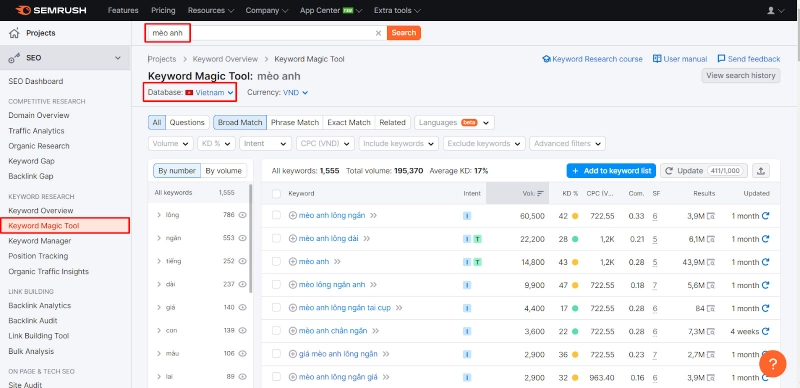
From here, you can build important topics and optimize SEO for your website.
Expanded List Post Method
Expanded List Post is a method focusing on expanding keyword scope based on specific topics to comprehensively cover the market and optimize SEO effectiveness.
Check out the video below for details on how to implement the Expanded List Post method:
Difference with Phantom Keywords
Unlike Phantom Keywords (keywords with search volume but are rarely or never optimized), Expanded List Post emphasizes:
- Optimization according to Google's latest trends.
- Content development based on topics to broaden coverage and fully capture the market.
Effectiveness of Expanded List Post
- Discover high-traffic topics: This method focuses on topics that attract significant attention from potential customers.
- Reduce competition compared to Phantom Keywords: Instead of targeting highly competitive keywords, you expand deeply into less-contested topics.
- "Leverage effect" for related keywords: When a topic is optimized and ranks well, it boosts the ranking of multiple related keywords.
The result? You can get dozens, even hundreds of thousands of keywords ranked on search engines!
When to Use?
This method is particularly suitable for established websites struggling to find new ideas.
Researching Additional Market Information
Every business activity, not just SEO, requires market research. While keyword research tools are very useful, they are only third-party tools providing reference information. It’s essential to understand that data from these tools cannot be completely accurate and often lags behind constantly evolving market trends.
Fluctuation in User Intent
User search intent (search intent) evolves continuously. It can differ from one day to the next, let alone over months or quarters. This creates a certain delay in SEO tool data, as they require time to collect and update information.
Limitations of SEO Tools
- SEO keyword research tools cannot provide real-time insights.
- Over-reliance on these tools can cause delays in SEO efforts and missed opportunities to capture emerging trends.

How to Address These Issues
After gathering a list of keywords using the methods mentioned earlier, perform filtering and selection steps:
- Assess keyword quality: Focus on high-potential keywords aligned with your target market.
- Combine with practical research: Use feedback from customers, trends on social media, and industry insights to supplement your data.
- Update continuously: Monitor market changes closely to adjust your SEO strategy promptly.
Balancing data from tools with practical market information allows you to craft an effective SEO strategy that meets user demands.
Step 3: Define Criteria for Keyword Selection
After identifying a list of Seed Keywords, the next step is filtering and selecting suitable keywords based on specific criteria. These include Opportunity, Volume, Keyword Difficulty, and Potential.
Opportunity
"Opportunity" evaluates whether your website can develop content related to the keyword. This step helps eliminate keywords unrelated to your business field or website's main topic.
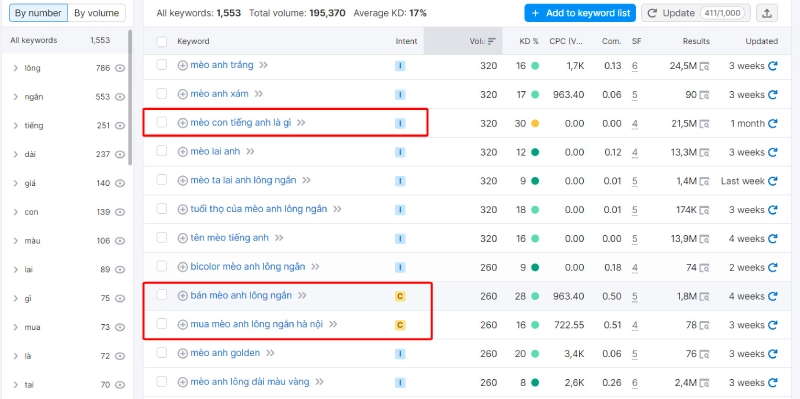
-
How to Evaluate:
- Exclude keywords with unrelated search intent.
- Focus on keywords where your business can "own" or provide valuable content.
-
Example:
For a website specializing in cats, prioritize keywords like:- "cat characteristics"
- "cat prices"
- "cat care tips"
- "best places to buy cats"
Conversely, exclude unrelated keywords like "dog food" or "dog accessories."
Volume (Search Volume)
"Volume" measures the average monthly search volume for a keyword. Keywords with high search volumes often offer significant opportunities to reach more users.
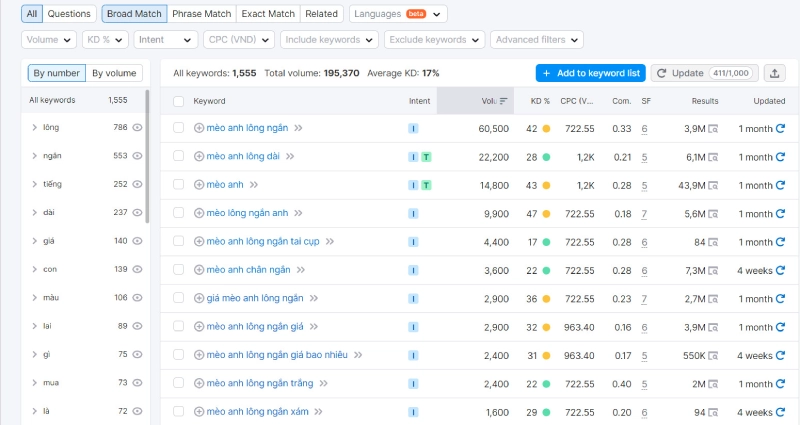
- How to Implement:
- Use tools like SEMrush, Ahrefs, or Google Keyword Planner to check search volume.
- Choose keywords with search volumes aligned with your strategic goals (prioritize keywords with medium to high volume).
Keyword Difficulty
"Keyword Difficulty" (KD) indicates how competitive it is to rank for a keyword on search engines.
- How to Evaluate:
- Select keywords with moderate difficulty, especially if your website is new or lacks domain authority.
- Keywords with a KD between 0-50 are generally good for beginners.
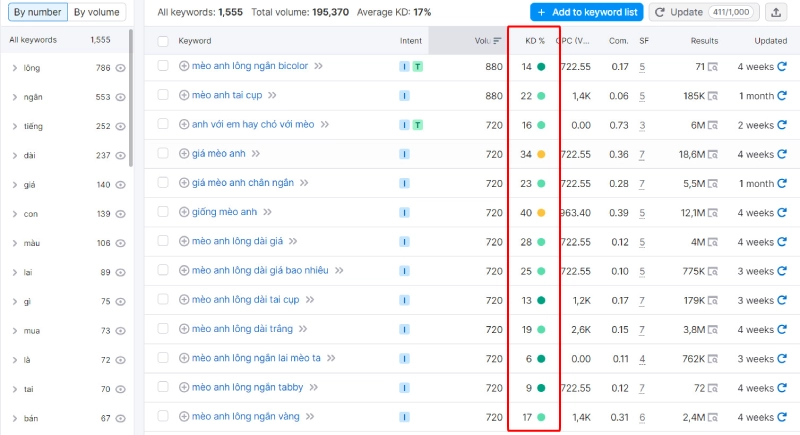
Potential
"Potential" assesses the overall value of a keyword, considering factors like search volume, competition, and alignment with business objectives.
- How to Determine:
- Evaluate the conversion potential of a keyword (can it generate revenue or high-quality traffic?).
- Assess the ability to expand content around the keyword to build additional long-tail keywords.
Step 4: Categorize Keywords by Search Intent
Categorizing keywords based on search intent helps you understand user behavior and optimize content for better SEO performance. Below are the main keyword types:
Informational Keywords
Informational keywords are searched by users seeking knowledge or answers to specific questions. These queries often start with:
- "How", "What", "When", "Who", "Where"
- "Cách", "Làm thế nào", "Nguyên nhân", "Định nghĩa", etc.
Examples:
- "What are British Shorthair cats?"
- "How much does a British Shorthair cat cost?"
- "How to care for British Shorthair cats."
This type of keyword is suitable for guides, tutorials, in-depth articles, and FAQs.
Navigational Keywords
Navigational keywords are used when users already know their destination, often referencing a brand, product, or specific service.
Characteristics:
- Direct users to a specific website.
- Often include brand, product, or service names.
Examples:
- "Ahrefs" → leads to ahrefs.com.
- "Facebook" → leads to facebook.com.
- "RiverLee web design service" → leads to riverlee.vn.
These keywords are crucial for brand-building and directing traffic.
Commercial Investigation Keywords
Commercial investigation keywords are used when users compare or evaluate products, seeking reviews or recommendations.
Examples:
- "Should I adopt a British Shorthair cat?"
- "Compare British Shorthair and Persian cats."
- "Affordable British Shorthair cats vs. Persian cats."
These keywords are ideal for reviews, comparisons, or detailed analyses.
Transactional Keywords
Transactional keywords show purchase or service intent, often containing words like "buy," "price," "order," or "discount code."
Characteristics:
- Usually long-tail keywords targeting specific user needs.
- High conversion potential but often competitive.
Examples:
- "Buy British Shorthair cats under $50."
- "Affordable British Shorthair cats in Hanoi."
- "British Shorthair cat price $200."
Note: Focus on long-tail keywords to reduce competition and improve conversion rates.
Step 5: Group Keywords
Keyword Grouping is the process of listing and clustering keywords with similar meanings or shared user intent into groups. This approach helps you organize keywords into specific topics, making content and SEO strategies more effective.
Parent Keyword
In keyword grouping, the concept of Parent Keyword plays a key role. A Parent Keyword represents a broad topic or niche focus area. While users may search using various keywords, their search intent often converges around a central topic, which the Parent Keyword encapsulates.
How to Select a Parent Keyword
To choose a suitable Parent Keyword, consider the following:
- Business Domain: The keyword must be directly related to your field, products, or target audience.
- Search Intent: Ensure all keywords in the group share the same search intent.
Example: For a topic like "pet cats," you might be torn between the keywords "foreign cat breeds" and "beautiful cat breeds."
- Open two incognito tabs in your browser and search for each keyword.
- If the SERP (Search Engine Results Page) results are similar and revolve around the same topic (e.g., different cat breeds), you can group both keywords under the "pet cats" category.

How to Group Keywords
Manual Method:
-
Search Each Keyword on Google:
- Open an incognito tab and search the keyword.
- Check if the results share similar content.
- If the results align with the Parent Keyword, you can group them together.
-
Verify Search Intent:
- Ensure all keywords in the group satisfy the same user needs or objectives.
Using SEO Tools:
If you’re handling a large number of keywords, SEO tools can save time:
- Ahrefs – Parent Topic Functionality:
- Enter a Seed Keyword or Head Keyword into the search bar.
- Ahrefs’ algorithm will automatically group keywords with similar intent under a larger Parent Topic.
Example:
Entering "SEO services" into Ahrefs returns a list of related keywords organized by Parent Topic. This is especially useful for quickly identifying potential keyword groups.
Note: While tools are helpful, you should manually verify the results to ensure they align with your strategic goals and real-world market conditions.
When to Group Keywords
Grouping keywords is crucial in two scenarios:
-
When you already have a complete keyword list:
- This is the next step to organizing and optimizing your content strategy.
-
When running out of content ideas:
- During SEO campaigns, you might struggle to identify new topics or focus keywords. Analyzing keyword groups can suggest additional relevant topics.
Step 6: Expanding Keyword Ideas
To build a rich and comprehensive keyword list, expanding keyword ideas is essential. By leveraging tools and available resources, you can discover additional high-potential keywords, enhancing your SEO strategy. Here are some effective methods to expand keyword ideas:
Using Google and YouTube Suggestion Boxes
Google and YouTube are excellent tools for uncovering related keywords:
-
How to Use:
- Enter a topic or keyword into the Google Search or YouTube Search bar.
- As you type, both platforms will auto-suggest a list of related keywords below the search box.
- Review and note down the suggestions relevant to your goals.
-
Benefits:
- These keywords often reflect real user search behavior.
- They are free, fast, and easy-to-use sources for keyword ideas.
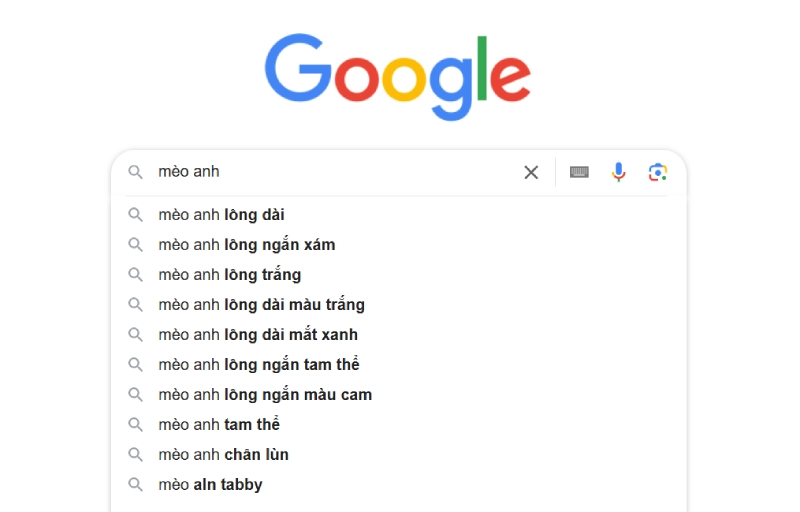
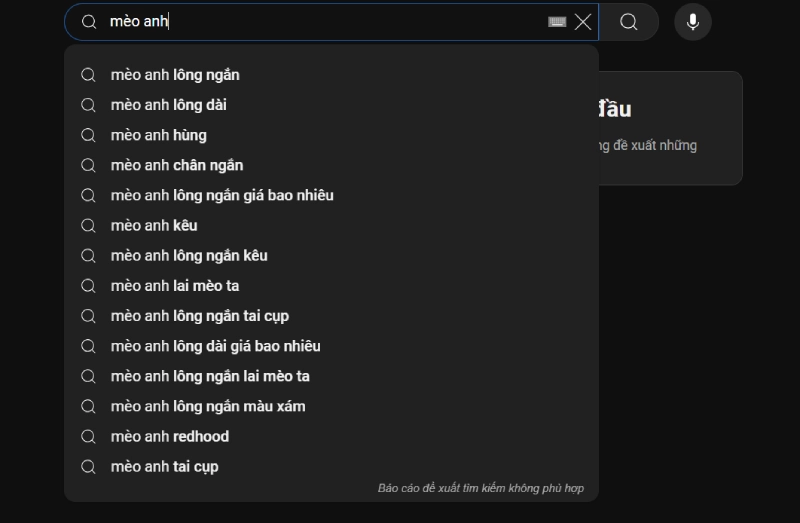
Search for Related Keywords
Besides suggestion boxes, Google also provides a "Searches Related to" section at the bottom of the results page.
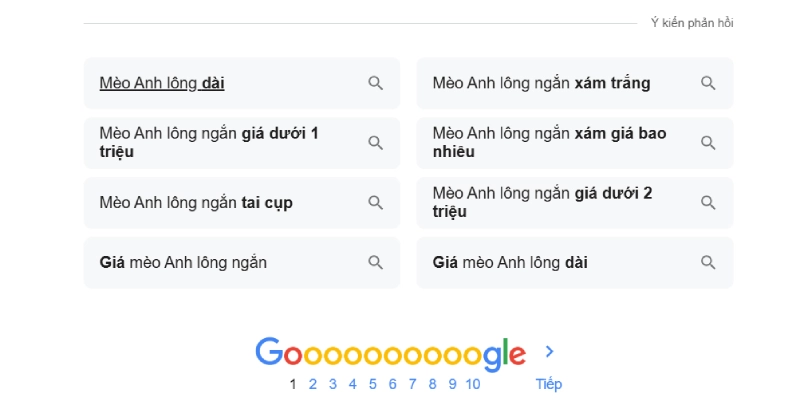
-
How to Use:
- Enter a primary keyword into Google Search.
- Scroll to the bottom of the results page to find the "Searches Related to" list.
- Record these related keywords to expand your list.
-
Image Tab Suggestions:
- Switch to the Images tab in Google Search.
- Keywords in the suggestion bar above (image tags) are also useful for keyword ideas.
Explore Keywords on Forums
Forums are hubs where users discuss topics of interest. They are great for capturing the language, questions, and concerns of your target audience.
- How to Use:
- Join forums relevant to your niche (e.g., Reddit, Quora, or industry-specific forums).
- Monitor popular posts, common questions, and trending topics.
- Note down frequently mentioned phrases and keywords.
Leverage Wikipedia's Table of Contents
Wikipedia is a vast repository of structured information curated by experts. It’s an invaluable resource for keyword research.
-
How to Use:
- Visit Wikipedia and search for a topic.
- Check the Table of Contents to identify subtopics and main sections.
- Extract relevant subtopics as potential keywords.
-
Benefits:
- Wikipedia offers a comprehensive overview of a broad topic, helping you identify relevant keywords for content creation.
Tips for Choosing Keywords for Implementation
Selecting the right keywords is a crucial factor in your SEO strategy, ensuring optimization efficiency and maximizing value for your website. Here are some key considerations:
Focus on Long-Tail Keywords
-
Characteristics: Long-Tail Keywords are detailed, longer phrases (usually 3+ words) that target specific user intents.
-
Advantages:
- Lower competition: Easier to rank for due to fewer competitors.
- Higher conversion rates: These keywords address specific user needs, boosting conversion potential.
-
Examples: Instead of a short keyword like "pet cats," opt for:
- "how to care for British Shorthair cats."
- "affordable British Shorthair cats in Hanoi."
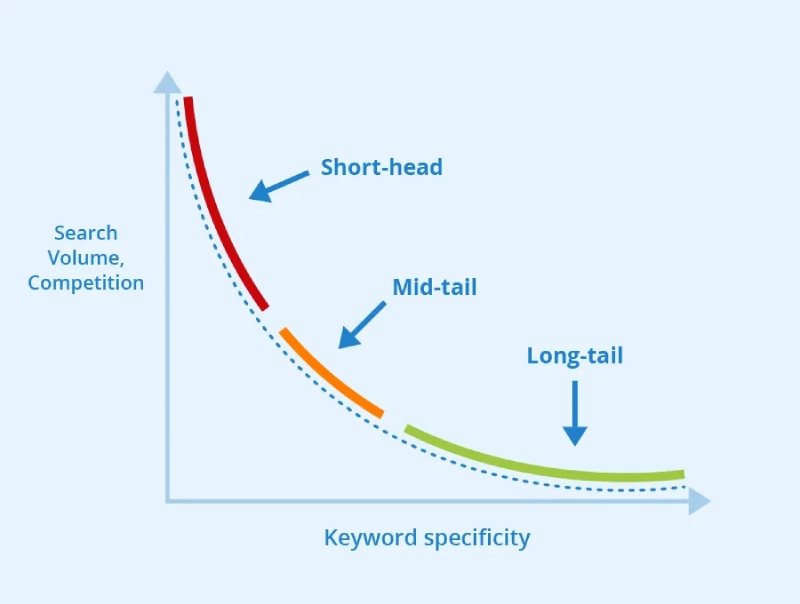
Start with Low-Competition Keywords, Then Scale Up
-
Strategy:
- Initial phase: Target low-competition keywords to build a strong foundation and gain domain authority.
- Later phase: Shift focus to more competitive keywords as your website grows in traffic and authority.
-
Benefits:
- Reduces SEO challenges.
- Ensures sustainable, effective growth over time.
Prioritize High-Conversion Keywords
-
Characteristics: High-conversion keywords drive users closer to taking action, such as making a purchase or booking a service.
-
Examples:
- "Buy British Shorthair cats under $200."
- "Discount codes for cat accessories."
-
Why Prioritize: These keywords directly impact revenue and optimize ROI (Return on Investment).
Focus on a Specific Topic or Niche
-
Reason:
- Concentrating on one topic enables in-depth content creation, enhancing your website's expertise and authority.
- Google favors websites with consistent, valuable content.
-
How to Implement:
- Group related keywords within the same niche and build content clusters around one main topic.
- For instance, if focusing on "pet cats," create related content like:
- “Top beautiful cat breeds.”
- “How to care for popular cat breeds.”
- “Pet cat prices in Vietnam.”
-
Benefits:
- Improves user experience through cohesive and logical content.
- Enhances search engine ranking with a well-structured content strategy.
How to Find Keyword Ideas for an Existing Website
Existing websites often already have researched and optimized keywords unless indexing and crawling were entirely disabled. Otherwise, you can analyze your data to see how your site ranks and identify related keywords for your niche.
Before evaluating whether your website content is fully SEO-optimized, consider the following four methods to effectively develop your keyword list:
#1. Analyze Your Existing Ranked Keywords
One essential SEO keyword research method involves using Google Analytics and Google Search Console to track the performance of keywords your website currently ranks for. In Google Search Console, the Search Analytics section provides data on keywords driving clicks (CTR) and ranking positions.
Steps:
- Access Google Search Console:
- Open Google Search Console and select the Performance section.
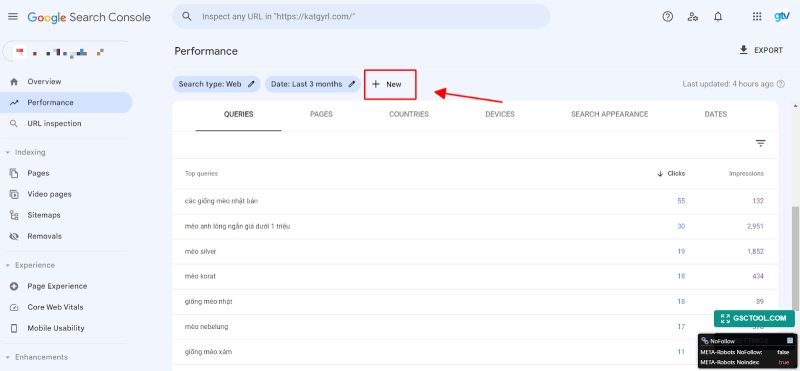
-
Filter Keywords by Specific URL:
- Narrow down relevant keywords by adding a filter “+ new” → Page → Choose Exact URL.
- Enter the URL you want to analyze and click Apply.
-
Review Results:
- Google Search Console displays a list of keywords your website ranks for, along with their average positions and the click-through impact they generate.
Note:
- Limitations of Search Console:
While Google Search Console provides valuable data on rankings and CTR, it does not offer information on the monthly search volume of keywords.- You are also limited to accessing the top 1,000 keywords, so if you need deeper analysis, you may need to combine it with other SEO tools like SEMrush or Ahrefs to get a more comprehensive view of your website’s keyword performance.
#2. Refer to Competitors' Ranked Keyword Lists
One effective way to expand your keyword list is by reviewing the keywords your competitors are ranking for. The SEMrush tool provides a highly useful feature called Domain Overview, which allows you to easily analyze and research competitors' keywords. Simply enter a competitor's URL, and SEMrush will automatically display a list of keywords their website ranks for, giving you insight into their SEO strategy.
Why Use SEMrush?
The opportunity here is that your competitors have already done part of the keyword research, saving you time and effort. You just need to pick the high-potential keywords from this list and integrate them into your SEO strategy.
If you haven't identified your competitors, you can search for seed keywords on Google and see who ranks at the top of the page for keywords in the same theme. For example, if your website is about animals, you might find competitors like tindongvat.com.
Steps to Use SEMrush for Competitor Keyword Analysis:
-
Select the "Domain Overview" Feature:
- Open SEMrush and, from the left-hand menu, select Domain Overview.
-
Enter the Competitor's URL in the Search Bar:
- Input the competitor’s URL in the search bar, select Vietnam (or your desired region), and click Search.
-
Check Results in the "Organic Research" Section:
- Scroll down to the Organic Research section. In the Top Organic Keywords part, click View details for more information.
-
Filter and Sort Keywords:
- A list of the competitor's keywords will appear. You can sort by position (Position) by clicking on Position twice to select the keywords for which your competitor is ranking highly.
-
Eliminate Irrelevant Keywords:
- Use the Advanced Filters feature to exclude keywords unrelated to your website’s topic, ensuring you only select keywords relevant to your niche and SEO goals.
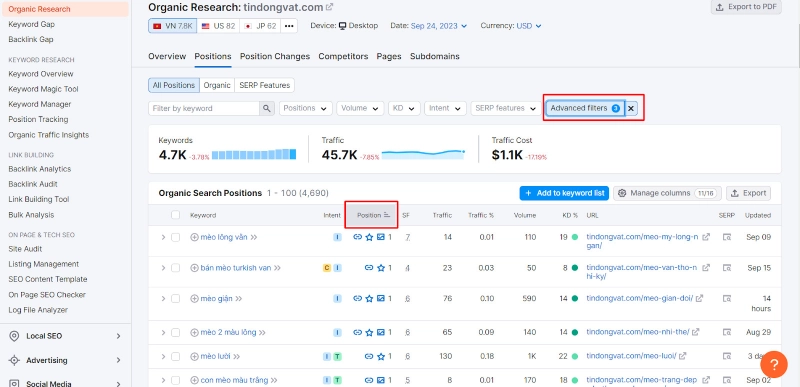
Benefits:
- Save time and effort in keyword research.
- Identify high-potential keywords successfully used by competitors.
- Develop smarter and more effective keyword strategies.
By analyzing competitors' keywords, you can discover untapped keyword opportunities and optimize your SEO strategy quickly and effectively.
#3. Use Professional SEO Keyword Research Tools
While competitor analysis can provide a long list of related keyword ideas, to truly excel in SEO, you need to identify "unique" keywords that your competitors have overlooked. This requires the use of professional keyword research tools to uncover hidden opportunities.
Popular Keyword Research Tools:
- Ahrefs
- SEMrush
- Keywordtool.io
- Ubersuggest
- And other keyword research tools.
Benefits of Using Keyword Research Tools:
These tools help you discover effective keyword ideas, even those that are underutilized. Simply input a seed keyword, and the tool will automatically suggest a list of related keywords. You can then filter the results to find the "unique" keywords that fit your SEO goals.
These tools often provide keyword suggestions based on the following sources:
- Ideas from Google Keyword Planner: Keyword research tools pull ideas directly from Google Keyword Planner to provide potential keywords.
- Google Auto-Suggest: Tools automatically suggest keywords based on what users frequently search for on Google.
- Similar Searches on Google: Tools provide lists of similar keywords suggested by Google, helping you expand your keyword ideas further.
Free Tool: Ubersuggest
Ubersuggest is a free tool that’s very useful for discovering keyword ideas. While it’s not as comprehensive as paid tools in terms of depth and specificity, it still provides valuable data on keywords like monthly search volume, competition, and trends. However, the free version only offers a limited number of keyword suggestions.
For example, when you search for "Content Marketing," Ubersuggest generates approximately 316 keyword ideas. Its strength lies in displaying monthly search volumes, giving you a clear overview of the keyword’s popularity.
Paid Tools: Ahrefs, SEMrush, Keywordtool.io
For more efficient and extensive keyword research, you can use professional tools like Ahrefs, SEMrush, or Keywordtool.io. These tools offer large keyword databases and provide numerous keyword ideas.
For instance, Ahrefs, through its Keywords Explorer feature, generates up to 5,570 keyword ideas for "content marketing." However, with such a large list, you’ll need to use filters to narrow down suitable keywords. These filters include:
- Keyword Difficulty: Assess the level of competition for the keyword.
- Search Volume: The average monthly search volume of the keyword.
- Clicks: The number of clicks generated by search results for the keyword.
- Clicks per Search: The average number of clicks per search query.
- Cost Per Click (CPC): The cost per click if you run ads for the keyword.
- Number of Words in a Keyword: The number of words in the keyword (helpful for distinguishing between short-tail and long-tail keywords).
#4. Effective Niche Market Research
While the previous strategies are highly effective for suggesting a variety of keyword ideas, they can also limit you to a specific framework. Relying solely on tools and competitors may cause you to miss great opportunities outside what the current market offers. That’s why niche market research is a critical step to discovering unique keywords that competitors haven’t explored, giving you a significant competitive advantage.
How to Think "Out-of-the-Box":
-
Put Yourself in the Shoes of Potential Customers:
- Who are your customers? Research your target audience thoroughly. Understanding their problems, questions, needs, and interests will help you pinpoint accurate keywords.
- What influences them? Factors like user psychology, life circumstances, or new trends can help you discover unexplored keywords.
-
Talk to Your Current Customers:
- Ask your customers about the questions they typically have when searching for your products or services. The way they phrase their issues may suggest new, high-potential SEO keywords you hadn’t considered.
-
Engage Actively in Niche Social Networks and Communities:
- Be an active member of forums, social media groups, or online communities related to your industry. These are great places to gather insights on customer language, issues they face, and emerging trends in your field.
-
Search for "Out-of-the-Box" Keywords:
- Sometimes, you need to step out of the box and look for keywords that aren’t too obvious or commonly targeted. These keywords may not directly relate to your services but attract customer attention and easily lead to conversions.
Examples of "Out-of-the-Box" Keywords for SEO Web Design Services:
If you offer SEO web design services, here are some “out-of-the-box” keywords to consider:
-
"How does Google determine the quality of a website?"
- This keyword may attract users interested in improving their website quality, even before they search for design services.
-
"Why isn’t my website appearing on Google?"
- A common question for beginners or those facing SEO issues, potentially leading them to your services for a solution.
-
"Buying old websites"
- An interesting and less common keyword, targeting individuals looking to sell or repurpose websites.
-
"How to fix a deindexed website"
- A serious issue for any website penalized or not indexed by Google. People facing this problem may need your SEO-compliant web design services.
Benefits of "Out-of-the-Box" Keywords:
- They often face lower competition and easily capture customer attention.
- You can dominate small, underutilized niche markets that bring in high-potential clients.
- They offer opportunities to create blog posts or FAQ content answering questions customers didn’t know they had.
Popular Keyword Research Tools
To optimize the keyword research process, using tools is indispensable. These tools not only save time but also provide detailed data on search volume, competition, and keyword trends. Below is a list of popular keyword research tools divided into free and paid categories.
Free Tools
-
Google Keyword Planner
- Provides accurate data on:
- Search Volume: Monthly search volume.
- Competition: Keyword competition levels.
- Cost Per Click (CPC): CPC for Google Ads campaigns.
- Suitable for both SEO and paid advertising campaigns.
- Provides accurate data on:
-
Google Trends
- Tracks search trends over time and by region.
- Useful for identifying seasonal keywords or trending topics.
-
Google Search Box (Autocomplete)
- Suggests related keywords when typing queries into the search bar.
Example: Typing “wooden table” into the search bar might suggest terms like “folding wooden table,” “cheap wooden table for living room.”
- Suggests related keywords when typing queries into the search bar.
-
AnswerThePublic
- Displays popular user questions related to your keywords.
- Ideal for generating content ideas based on common queries and popular topics.
Paid Tools
-
Ahrefs
- One of the most powerful SEO tools available:
- Find related keywords.
- Analyze Keyword Difficulty.
- Track SEO performance and research competitors.
- Key Feature: Groups keywords by Parent Topic, making it easy to create content clusters.
- One of the most powerful SEO tools available:
-
SEMrush
- Provides detailed data on:
- Keywords your competitors are ranking for.
- Search volume, competition, and CPC.
- Unique Feature: Suggests keywords based on your existing content, optimizing your SEO strategy.
- Provides detailed data on:
-
Keyword Tool.io
- Uses Google Autocomplete to suggest long-tail keywords.
- Suitable for finding keywords with specific search intents.
-
KW Finder
- Specializes in identifying low-competition keywords with high value.
- Ideal for new websites targeting long-tail keywords.
How to Choose the Right Tool
- If You’re Just Starting: Use free tools like Google Keyword Planner and Google Trends to get familiar with keyword research.
- If You Want In-Depth Analysis: Paid tools like Ahrefs or SEMrush are optimal for competitor research and long-term strategy building.
- If You Focus on Long-Tail Keywords: Keyword Tool.io or KW Finder are excellent choices.
Differences Between SEO Keywords and Google Ads Keywords
When engaging in SEO or online advertising, many people confuse SEO keywords with Google Ads keywords. While both aim to increase visibility on search engines, their goals, usage, and results differ significantly. Understanding these differences will help you optimize your online marketing strategy more effectively.
SEO Keywords
- Objective: Increase organic traffic to the website (Organic Traffic).
- Characteristics:
- Keywords are often longer (Long-tail Keywords) to target specific search intents.
- No cost per click, but requires investment in content creation and technical optimization.
- Optimized for long-term results, which can take 3-6 months to materialize.
Example:
The keyword "how to preserve wooden furniture" might be used in a detailed guide to attract users searching for information on this topic.
Google Ads Keywords
- Objective: Generate paid traffic (Paid Traffic) through Google Ads.
- Characteristics:
- Keywords are shorter and have high search volume to maximize visibility.
- Costs are calculated per click (CPC - Cost Per Click).
- Provides immediate results but depends on the advertising budget.
Example:
The keyword "buy premium wooden furniture in Ho Chi Minh City" could be used in an ad campaign to appear instantly at the top of the search results.
Overview Comparison: SEO Keywords vs. Google Ads Keywords
| Aspect | SEO Keywords | Google Ads Keywords |
|---|---|---|
| Objective | Improve organic rankings and long-term traffic | Display ads and boost traffic quickly |
| Cost | Free, not calculated per click | Pay-per-click (CPC) |
| Timeframe for Effectiveness | Long-term (3-6 months or more) | Short-term, effective as soon as the campaign runs |
| Keyword Type | Long-tail keywords with clear intent | Short keywords, highly competitive |
| Display Position | Organic results on the search page | Top or bottom of the search page |
When Should You Use SEO Keywords and Google Ads Keywords?
-
Use SEO Keywords:
When you aim to build sustainable, long-term value by focusing on in-depth content to attract organic traffic without relying on an advertising budget. -
Use Google Ads Keywords:
When you need quick traffic, especially for promotional campaigns, product launches, or driving short-term sales.
Combining SEO Keywords and Google Ads Keywords: A Comprehensive Strategy
Rather than focusing on just one method, combining both SEO keywords and Google Ads keywords allows you to harness the strengths of both approaches. This ensures long-term organic traffic while delivering instant results through advertising campaigns.
Benefits of Combining SEO and Google Ads Keywords
- Cost Optimization: SEO keywords reduce reliance on ad budgets, while Google Ads deliver immediate results to accelerate conversions.
- Multi-Channel Strategy: Combining SEO and Ads helps you dominate more positions on search engine results pages, boosting visibility and brand recognition.
- Fast Performance Measurement: Google Ads allows you to quickly test keyword effectiveness before integrating them into long-term SEO strategies.
How to Combine Effectively
-
Use Google Ads to Test SEO Keywords:
Before committing to an SEO strategy for a keyword, run Google Ads campaigns to measure:- Click-Through Rates (CTR).
- Relevance to customer search intent.
-
Leverage Google Ads Data to Optimize SEO Content:
Analyze high-performing keywords from Google Ads and incorporate them into your long-term SEO strategy. -
Increase Visibility:
During high-competition periods (e.g., product launches), use Google Ads to secure top positions on search results pages while maintaining organic rankings through SEO content. -
Capitalize on Long-Tail Keywords:
Use long-tail keywords from your SEO strategy to lower CPC costs and increase conversion rates in Google Ads.
Practical Example: Wooden Furniture Business
- SEO: Focus on optimizing keywords like "how to preserve wooden furniture" to build sustainable content and attract long-term traffic.
- Google Ads: Run ads for keywords like "buy affordable wooden chairs in Hanoi" to quickly reach customers ready to make a purchase.
Conclusion: Keyword Research – The Key to a Successful SEO Strategy
Keyword research is not just a step in the SEO process; it is the foundation that guides all website optimization activities. A successful SEO campaign begins with understanding what your customers want, what they are searching for, and how to meet those needs.
Key Takeaways:
-
What is Keyword Research?
- A process to identify and analyze the most valuable keywords for building effective content and SEO strategies.
-
Why is Keyword Research Important?
- Understand customer needs and search behavior.
- Optimize content and resources intelligently for long-term results.
-
Keyword Research Process:
- For new websites: Focus on long-tail, low-competition keywords and build sustainable content.
- For existing websites: Optimize current keywords, analyze competitor keywords, and explore niche markets.
-
Use Supporting Tools:
- Tools like Google Keyword Planner, Ahrefs, and SEMrush help maximize data utilization and make optimal keyword choices.
-
Differences Between SEO and Google Ads Keywords:
- SEO keywords align with long-term strategies, while Google Ads keywords deliver immediate results.
Don’t hesitate to experiment and measure results. Treat keyword research as a continuous cycle rather than a one-time task. Success in SEO requires patience, a clear strategy, and consistent effort.
Latest Posts

Lesson 26. How to Use break, continue, and return in Java | Learn Java Basics
A guide on how to use break, continue, and return statements in Java to control loops and program execution flow effectively.

Lesson 25. The do-while Loop in Java | Learn Basic Java
A detailed guide on the do-while loop in Java, including syntax, usage, examples, and comparison with the while loop.

Lesson 24. How to Convert Decimal to Binary in Java | Learn Basic Java
A guide on how to convert numbers from the decimal system to the binary system in Java using different methods, with illustrative examples.

Lesson 23. How to Use the While Loop in Java | Learn Java Basics
Learn how to use the while loop in Java with syntax, real-world examples, and practical applications in Java programming.
Related Posts

What is Domain Authority? 13-Step Guide to Improve DA Score for Your Website in 2025
Discover what Domain Authority is and its importance in SEO. A detailed guide on the 13-step process to effectively increase DA, from content research and technical optimization to building quality backlinks for a sustainable SEO strategy.

What is Page Authority? The Importance of Page Authority for SEO in 2025
Learn what Page Authority (PA) is and its role in SEO optimization to help improve your website's ranking on search engines in 2025.

What is Google Index? A Guide to 13 Ways to Speed Up Website Indexing in 2025
Discover what Google Index is and learn detailed guidelines on 13 effective ways to get your website indexed quickly and boost your SEO rankings on Google in 2025.
![What is Onpage SEO? 23+ Basic & Advanced Onpage Optimization Checklist [2025]](/blog-posts/seo-onpage/seo-onpage-thumb.jpg)
What is Onpage SEO? 23+ Basic & Advanced Onpage Optimization Checklist [2025]
Learn the concept of Onpage SEO and the 23+ basic to advanced Onpage optimization checklist to improve website quality and boost search rankings effectively.

